Enhancing AR and VR Experiences with Nearpod
Augmented Reality (AR) and Virtual Reality (VR) have transformed the way we engage with digital content. Nearpod is one of the tool that seamlessly integrates AR and VR elements into their lessons and presentations. In this blog post, I will explore how Nearpod can elevate AR and VR experiences, revolutionizing the way we learn and engage with virtual content.
Collaborative VR presentations: Nearpod facilitates collaborative learning by allowing students to create and present their own VR presentations. With Nearpod’s VR creator tool, students can design virtual environments and populate them with multimedia content, including images, videos, and 3D models. Data Visualization in AR and VR: Nearpod enables educators to transform data into interactive visualizations in AR and VR formats. Using Nearpod’s interactive charts and graphs, educators can present data dynamically and engagingly, allowing students to explore and interact with the data visually. In addition, Nearpod allow the teacher to take their students on virtual field trips using a smartphone. By incorporating 360-degree images and videos.
Overall, Nearpod’s advantages in the classroom lie in its ability to engage students, personalized instruction, and promote collaboration. With the help of Nearpod, educators can create dynamic and interactive learning experiences that enhance student learning outcomes.

Virtual Reality in Classrooms
In an era where technology is transforming educational environments, Virtual Reality (VR) and Augmented Reality (AR) are emerging as revolutionary technologies. Platforms like as Veative, Nearpod, and YouTube 360 videos not only improve the learning experience, but also pave the road for successful global cooperation in K-12 education.
Why Virtual Reality?
Virtual Reality provides an immersive and interactive learning environment that engages students in ways that traditional approaches cannot. It allows the students to “experience” rather than simply “learn,” making difficult ideas more understandable.
The Power of Veative
Veative is an educational platform that provides a diverse set of VR modules on topics ranging from science and math to history and geography. Teachers can use Veative to develop customized classes based on their curriculum, including VR experiences that virtually bring students to other regions of the world.
How Veative Can Be Used For Global Collaborations
Virtual Field Trips: Teachers can take students on virtual field trips to discover sights, cultures, and ecosystems from all over the world. This can help students have a better knowledge and appreciation for global diversity.
Collaborative Projects: Students from all over the world can work together on projects using the Veative platform to solve challenges and exchange insights, developing cross-cultural understanding and collaboration.

Image Source: https://www.unicef.org/innovation/stories/veative-labs-making-educational-content-more-accessible-through-webvr
Nearpod: Interactive Learning for Global Understanding
Interactive Lessons: Teachers can use Nearpod’s VR and AR technologies to build interactive classes that allow students to experience foreign cultures, languages, and traditions.
Global Discussions: Nearpod’s collaborative capabilities allow students to join in global discussions, share their ideas, and learn from their peers all over the world.
YouTube 360 Videos
YouTube 360 videos provide a huge library of immersive information that can be used in classroom lessons. Teachers can make their own list of 360-degree videos that correlate with their curriculum, giving students a virtual view into the world.
How YouTube 360 Videos Can Connect to Global Collaborations:
How YouTube 360 Videos Can Foster Global Collaborations:
Cultural Immersion: Teachers can use YouTube 360 videos to immerse students in various countries, traditions, and environments, thereby increasing cultural knowledge and understanding.
Collaborative Viewing: Students can watch and discuss 360-degree videos together, exchanging observations and insights to promote worldwide collaboration.
Lesson Plan: Exploring Global Landmarks with Veative
The lesson plan objective would be to explore and learn the chosen global landmarks using Veatives’s VR modules.
The materials needed would be the Veative app downloaded onto a tablet, and worksheet with questions to help guide exploration.
The introduction would be to introduce the chosen landmark/s, and why it is important, then divide the students into pairs or small groups.
The student will then explore the virtual world with the Veative app. Encourage the students to take notes about what they find, to later discuss its significance.
The students will now take place in a group discussion. Students will share what they saw and found. Students can compare and contrast the different things explored virtually, highlighting the diversity of the global cultures.
Then, reflect as a whole class on how important it is for understanding and appreciating global diversity. Ask students how they can use what they learned when they do global collaborations.
Using AR in the Classroom
Virtual and Augmented Reality can be amazing tools for the classroom, especially Augmented Reality (AR). With AR, all you need is a device with a camera and anything can be projected onto your surroundings. This is incredibly useful for schools, because it allows students to interact with objects they might not be able to otherwise.
For example, the app AR Chemistry Lab has tons of experiments. You don’t need access to any kind of glassware or expensive chemicals. Not only is this great for schools with less funding, but it works for classes with students who can’t handle using real chemistry equipment.

Of course, there are many more AR apps out there. There are infinite possibilities for VR/AR software, and infinite possibilities for including it in lesson plans.
Using Nearpod
Creating and presenting interactive presentations, formative or summative exams, and content on social justice, digital citizenship, vocabulary, SEL, and other topics may all be done with Nearpod. With Nearpod, teachers may incorporate interactive elements into any lesson—in a physical or virtual classroom. The idea is straightforward. A teacher can make interactive presentations with polls, videos, collaborate boards, quizzes, and other features.

The Nearpod app has a ton of amazing features. Its ability to create and share interactive presentations is possibly its best feature. This is an excellent method of involving pupils in the class and keeping their attention. Moreover, Nearpod offers an abundance of tools and resources to assist users in making the most of the app. Additionally, Nearpod users form a vibrant community that is always eager to lend a hand and encourage one another. It is among the most widely used educational applications on the market. There are numerous explanations for its appeal. However, let’s talk about how it functions and is accessible first.
Nearpod has numerous advantages when used in the classroom.
- It can, for starters, aid in boosting enthusiasm and involvement among students. Even if prepackaged classes can be edited and virtual reality can be incorporated into the classroom, learning can still be engaging.
- The interactive and multimedia-rich nature of Nearpod classes can also aid to maintain students’ interest in the subject matter.
- With Nearpod, educators can easily implement gamification in the classroom without requiring many tab clicks.
- Educators can offer students a more interactive learning environment by utilizing 3D models and simulations.
- Teachers can use Nearpod for post-session reports and immediate feedback.
- Finally, teachers may design a more customized remote learning experience for students because they can engage in Nearpod sessions using their own devices.
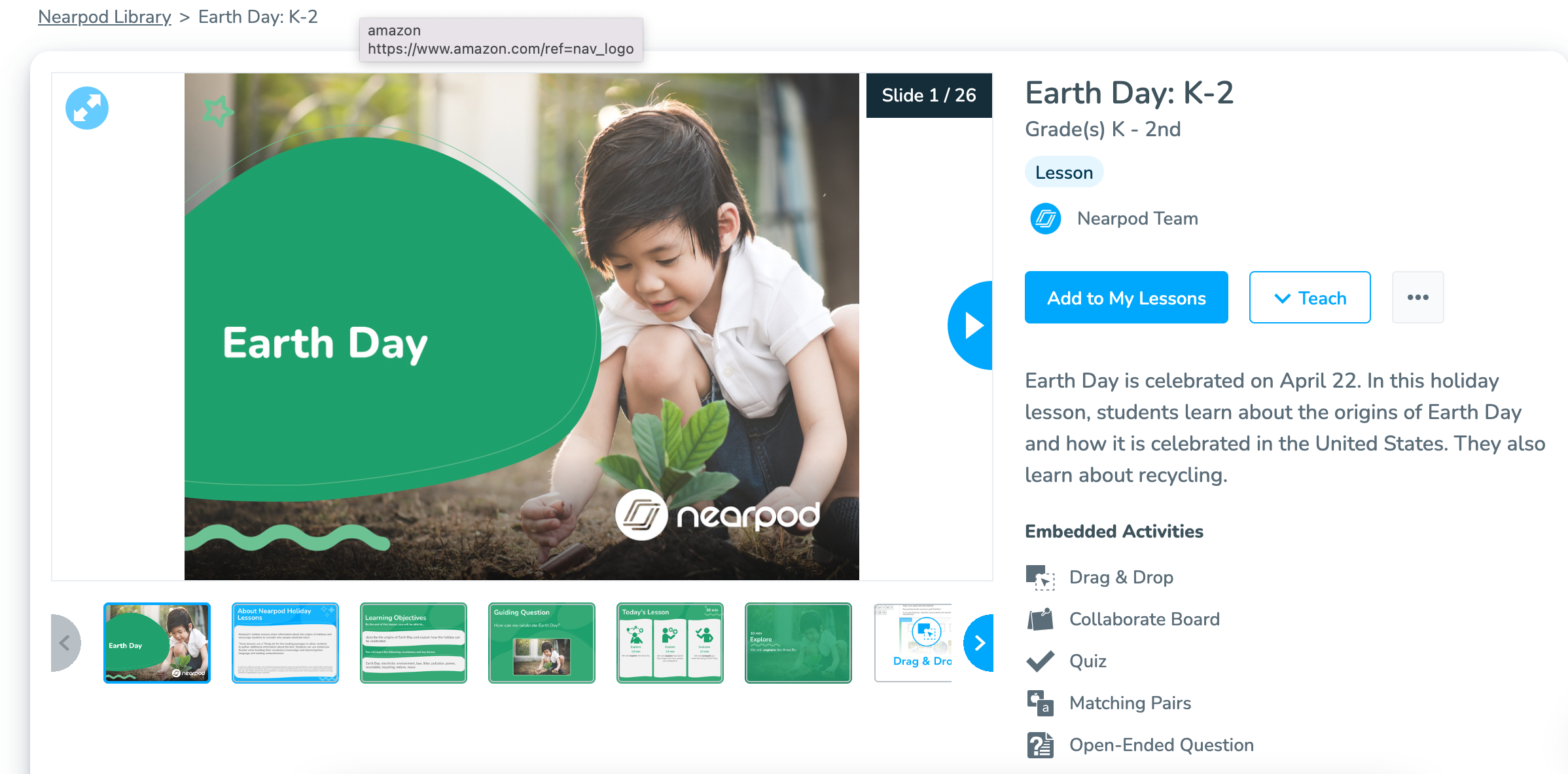
Here is an image of a Nearpod lesson for k-2 about Earth Day. I would use this Nearpod in my classroom.
Some Nearpod courses promote international cooperation by including virtual field visits to various locations, group projects with students from various countries, discussions of global concerns, cultural exchange activities, and language learning chances. Nearpod helps kids from different backgrounds develop empathy, cooperation, and cross-cultural communication skills through these exercises.
Virtual Reality in K-12 Classrooms with Nearpod
Nearpod is an educational platform designed to enrich classroom learning through interactive lessons and presentations. It empowers educators to create engaging content incorporating multimedia, interactive activities, quizzes, polls, and even virtual reality experiences. With Nearpod, teachers can deliver these lessons directly to students’ devices, fostering real-time engagement and feedback. Additionally, Nearpod offers features for teachers to track student progress and assess comprehension, ultimately aiming to elevate classroom participation and active learning.
Nearpod offers a wide variety of pre-made lesson plans spanning different subjects and grade levels. Educators can also create their own customized lesson plans using Nearpod’s templates and tools. From history to science to language arts, Nearpod provides comprehensive resources to support engaging and effective teaching.
Some Nearpod lessons encourage global collaboration by incorporating virtual field trips to destinations worldwide, collaborative projects involving students from different regions, cultural exchange activities, discussions on global issues, and language learning opportunities. Through these activities, Nearpod fosters cross-cultural communication, teamwork, and empathy among students from diverse backgrounds.
Example Lesson: https://nearpod.com/t/social-studies/kindergarten/asian-american-pacific-islander-heritage-month-k2-L133828595
The lesson I attached is a K-2 grade level lesson plan about Asian-American and Pacific Islander Heritage Month. Asian American Heritage Month is celebrated annually in May to honor the contributions and achievements of Asian Americans and Pacific Islanders in the United States. This lesson includes embedded activities such as drag and drop, collaborate board, matching pairs, open ended questions and a quiz. With these tools, students will learn about cultural heritage.

This is a screenshot I took of the lesson plan from their website.
Website link: https://nearpod.com/

Nearpod allows users to chose the grade level you want to teach and gives you over one-thousand lessons to chose from!
Virtual Reality in Education
Incorporating Virtual Reality into a classroom space is a cool and unique way of getting your students to learn. By allowing the child to have access to this technology, we are opening up a new door of education. VR in the classroom allows us to be fully immersed in the lesson. For example, if we are learning about animals wildlife, we can possibly join that animal’s environment and explore it by feeling like we are actually there. We can also learn math from a different perspective by having virtual reality at hand. This type of learning allows students to almost problem solve in a new perspective. It gives them the chance to investigate the situation while still learning the foundation of what the lesson is. Having Global Collaborations about different cultures and environments where other people in the world live is also a cool and unique use of having this tool inside the classroom. I think having a VR headset in a classroom would be a cool and fun addition to the classroom, and I would love to see what this form of technology would bring inside my own personal classroom when I have one.

Virtual Reality & its Benefits in Education
I have been doing a bunch of research on virtual reality and its benefits in education and its success in global collaborations. Virtual reality has really changed the game in general but has seriously changed the game in education. VR creates an entire digital environment, a 360-degree, immersive user experience that feels real. In a virtual reality setting, students can interact with what they see as if they were really there and some benefits are providing students with immersive learning experiences, other benefits of virtual reality in education include the ability to inspire students’ creativity and spark their imaginations. Virtual Reality can also be used to motivate students and allow them to explore new academic interests. Virtual Reality in education also helps students struggling to understand difficult academic concepts. Overall virtual reality has had great success when it comes to global collaborations. Virtual Reality enhances collaboration and increases productivity.

WE learning Virtual Center
The WE program, which is based on social and emotional learning and positive youth development, encourages adolescents to be their best selves and supports educators by equipping them with the necessary skills to become compassionate and future-ready citizens. I took a look at the Lesson Packages and Supporting Resources to see if I could fine any interesting lessons that I would want to use in my classroom.
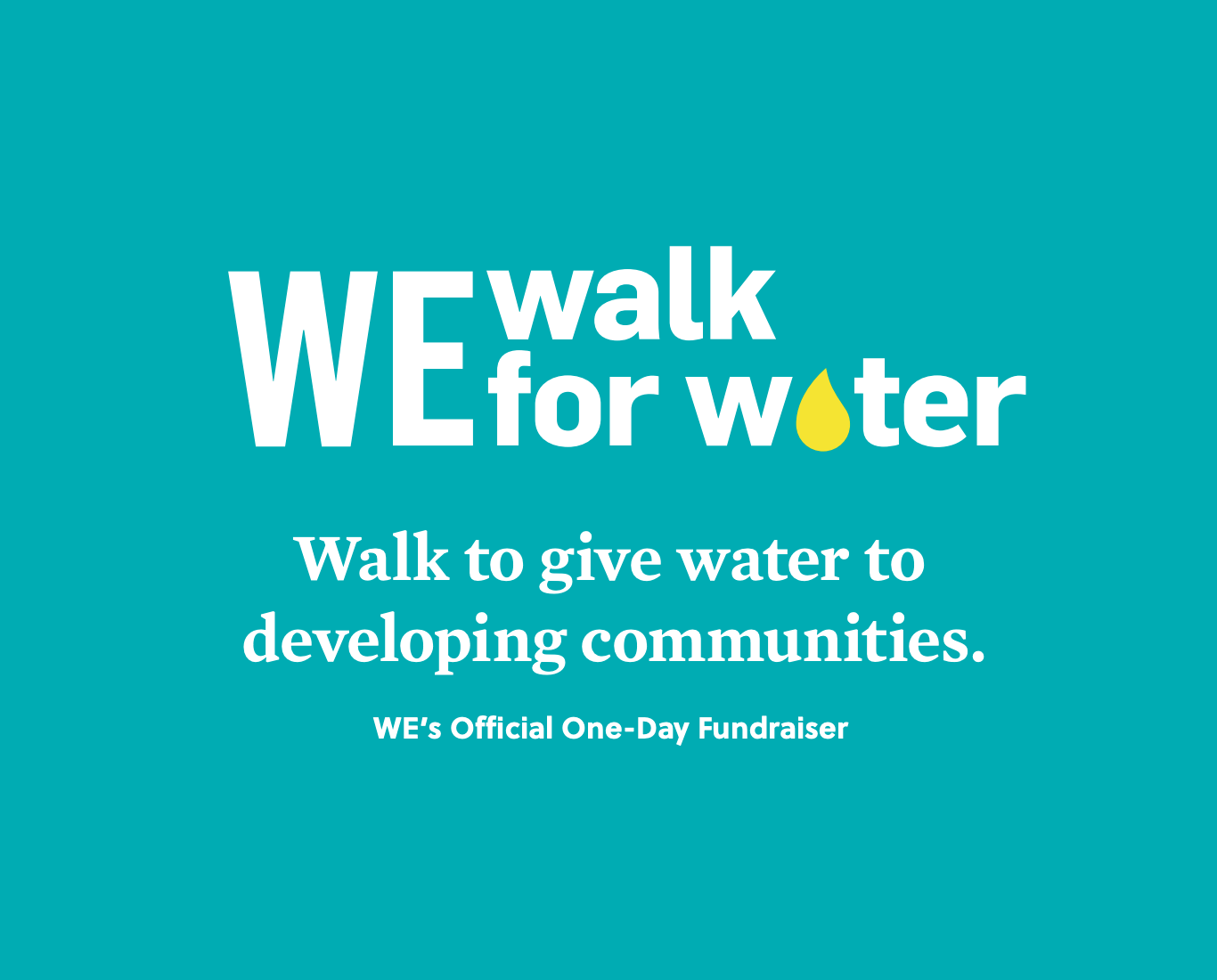
I came across the WE Walk For Water Campaign. The lesson states “With our Classroom Resources, educators can integrate service-based learning into their curriculum to broaden students’ understanding of issues they are passionate about.” There are 4 steps to this lesson/ campaign.
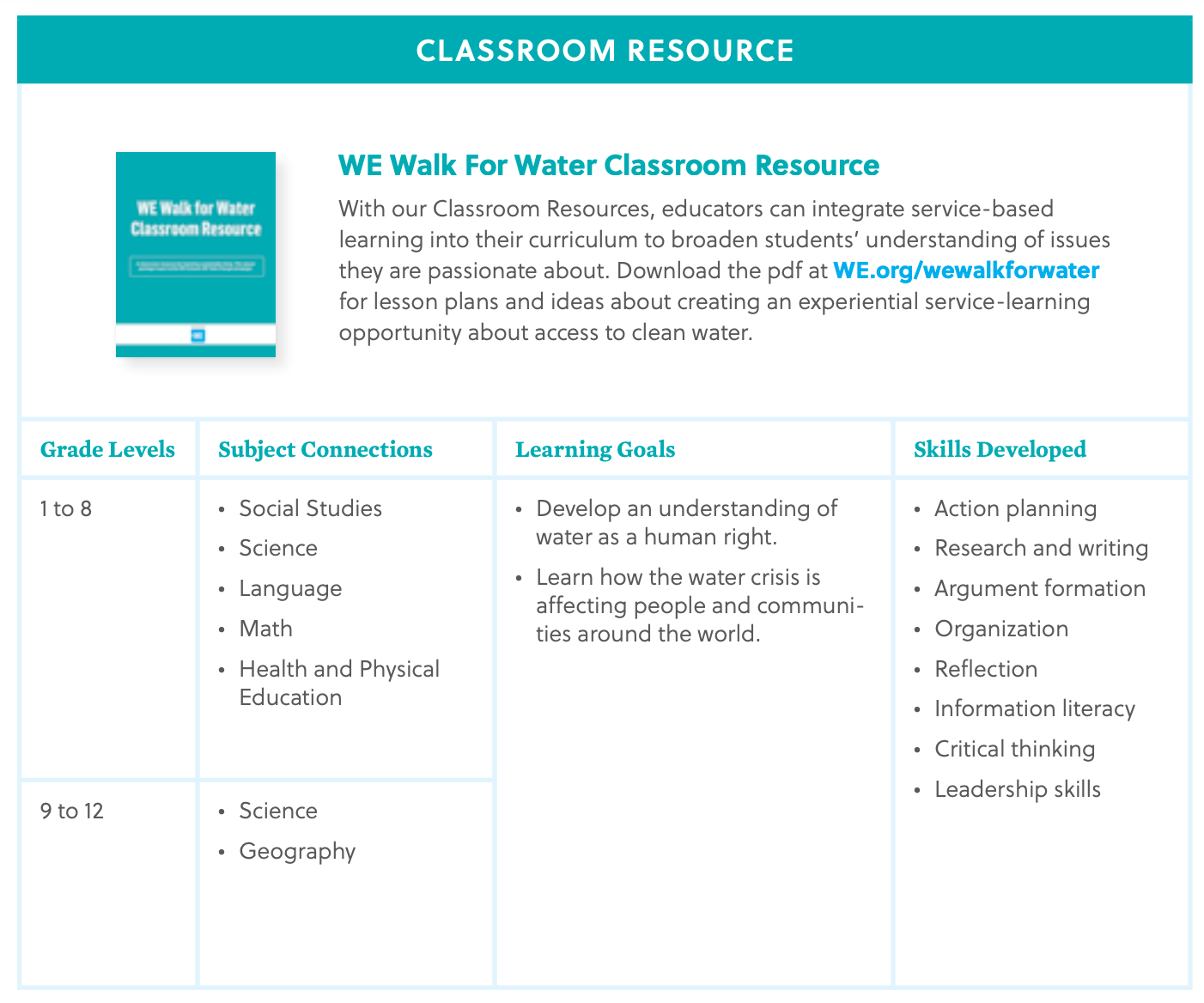
Step 1: Investigate and Learn
This step allows students to do some research, providing links and resources, with questions to support what they’ve learned.
Step 2: Action Plan
questions are asked about the student’s goals, and they will choose the date pf their walk. The, each group member is assigned a role in which they will carry out to the end of the campaign.
Step 3: Take Action
Student are directed to:
1- Make a donation page, a go found me, and explain why they are collecting money for clean water. They will create a team name and a goal.
2- spread the word, post on social media using #WEwalkForWater and tag @WEmovement.
3- Walk the walk, “On the day of your event, you will be walking for all of the women and children around the world who spend hours each day walking to collect water for their families. This walk and the money you’ve raised will create real impact in developing communities around the world.”
Students will then answer reflection questions about the fundraiser .
Step 4: Report and Celebrate
Students will answer report questions, and celebrate by posting the earnings to social media. At the end, Students will send in the earnings to the WE website.
I will be using the WE Virtual Learning Center in my future classroom, and I hope to do this exact lesson. Thank you!
WE Virtual Learning
Something that I found very interesting is this Schools Event Calendar. This is so people can come online and join these virtual events that this school does virtually.

It showed me some examples of events that the WE School teachers do and they share with other people. This is something that not only students, teachers or anyone can join virtually but something that teachers around the world can take advantage of and try out some of the activities they do virtually. This can give teachers some ideas to bring to their classrooms. Some examples I will picture below.
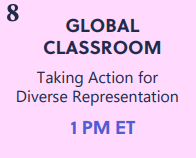

WE Schools: Empowering Youth, Transforming Communities, and Creating Future Leaders
Innovators, let’s talk about WE Schools, the unstoppable force in education. WE Schools is making waves and developing a new generation of compassionate leaders prepared to take on society’s most difficult problems, from empowering students to reforming communities.
Empowering Youth: The goal of our team at WE Schools is to enable youth to reach their full potential and change the world. Our objective? to provide them the drive, vision, expertise, self-assurance, and knowledge needed to tackle urgent problems on a local and international scale. Through the implementation of campaigns to eliminate bullying, raise money for clean water systems, or organize community clean-ups, kids learn that they have the ability to make a difference and form a lifelong dedication to civic participation, volunteerism, and philanthropy.
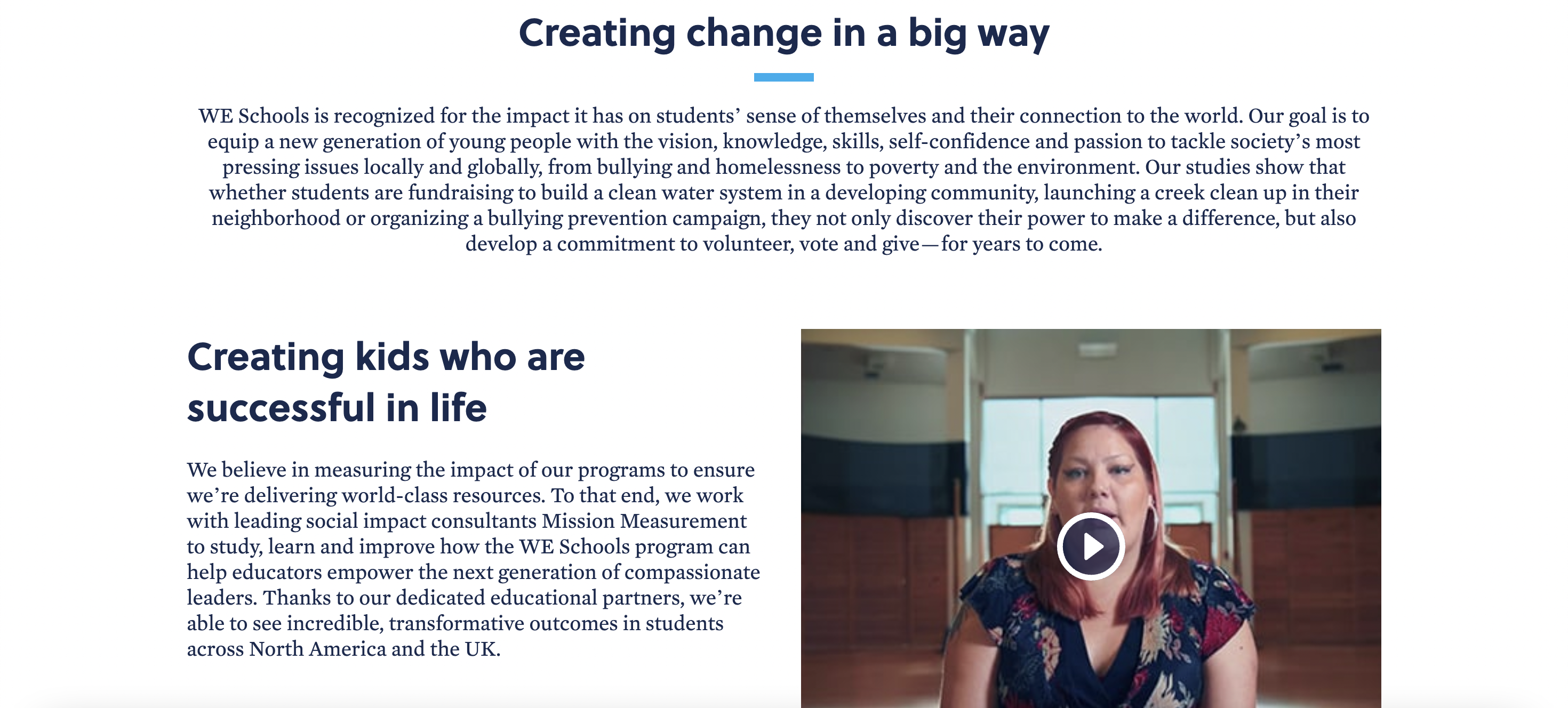
Measuring Impact: We walk the walk as well as talk the talk. In order to make sure we’re providing top-notch resources, we think it’s important to track the results of our initiatives. For this reason, we collaborate with top social impact advisors, Mission Measurement, to research, understand, and constantly enhance the ways in which WE Schools develop the next wave of altruistic leaders. And believe me when I say that the results speak for themselves: they have had a transformative impact on pupils in the UK and North America.
WE Schools by the Numbers: Let’s break it down. During the 2017–2018 school year, campaigns run by youth involved in WE Schools resulted in:
– $8.3 Million raised for social causes
– 10.8 Million pounds ($15.5 M in value) of food collected for local causes
– 12.7 Million hours volunteered for local and global causes
That’s not just numbers; that’s real impact, real change, and real difference-making.
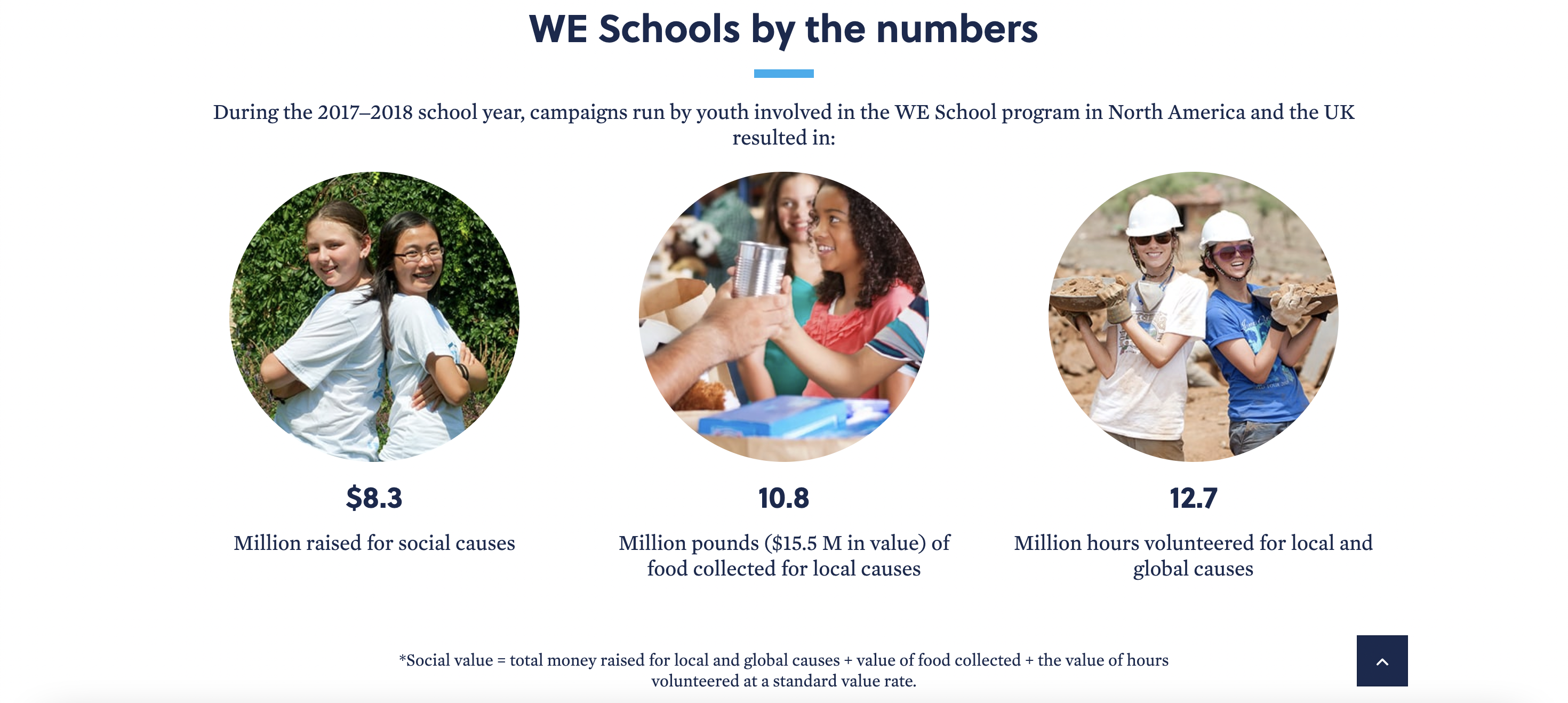
Transforming Youth: The worst part is this: According to 81% of educators, students who attend WE Schools are more inclined to take action to better lives both at home and abroad. Youth at WE Schools perceive themselves as change agents seven times more frequently than their peers do, and 90% of teachers believe that students are becoming more leadership-oriented. That’s what I mean when I say empowerment!
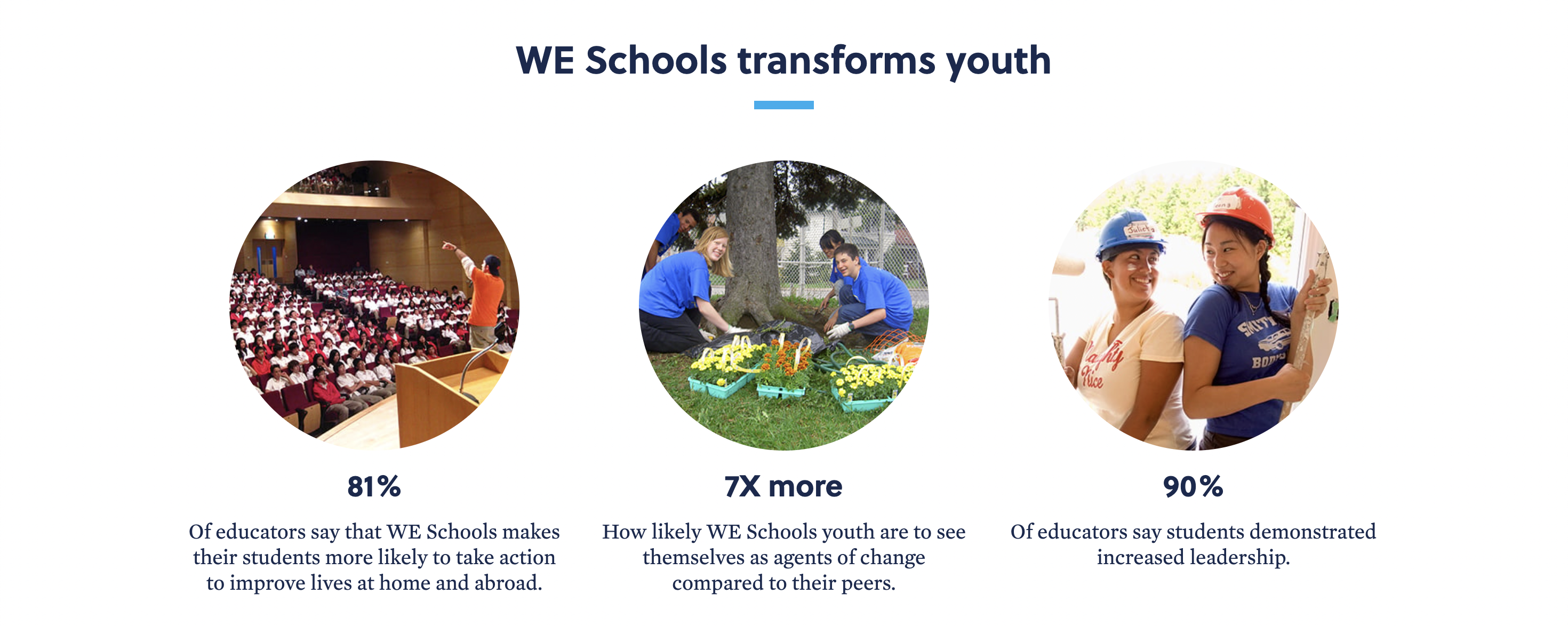
Empowering Educators: Not only do kids gain, but teachers also gain authority. Because of their involvement with WE Schools, 78% of them feel more fulfilled in their careers, and 82% of them have been able to find leadership possibilities for their kids. Furthermore, 76% of educators claim that WE Schools have helped them create a welcoming and safe atmosphere. How about changing things both inside and outside of the classroom?
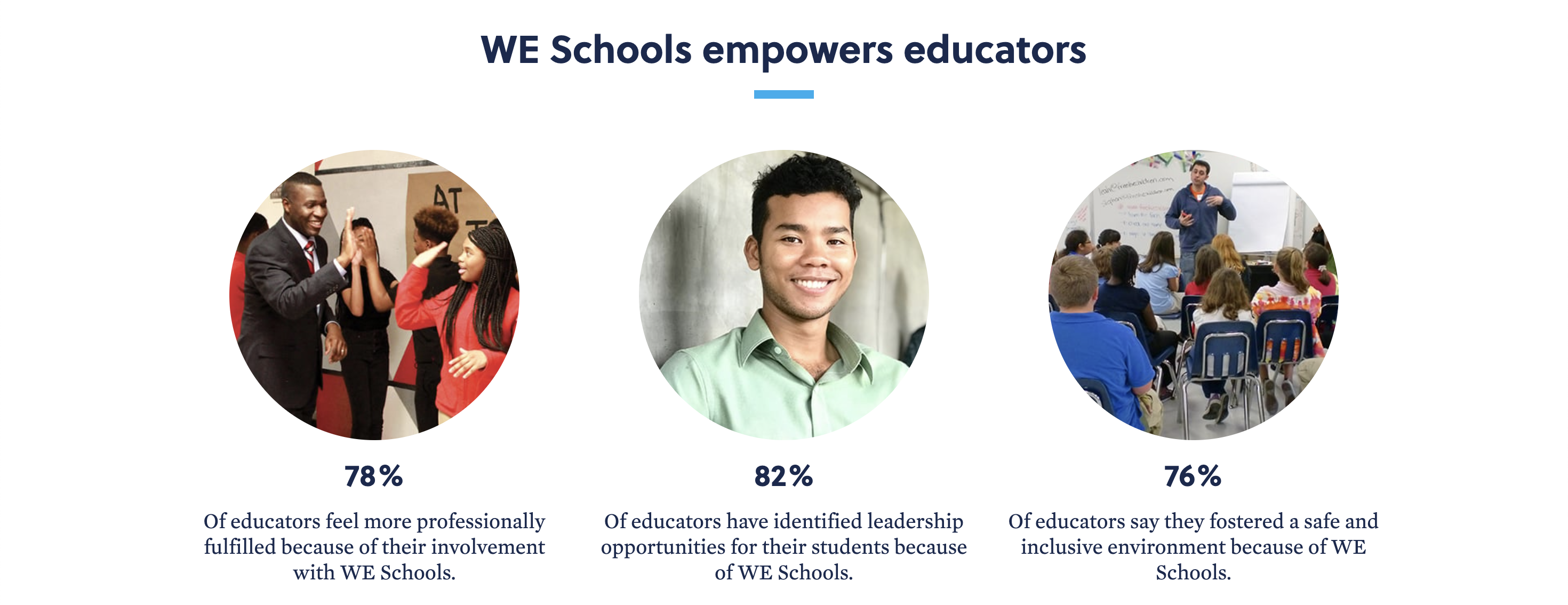
Preparing Young Leaders: The effects don’t end there. Because of their involvement with WE Schools, 73% of youth feel inspired to attend college, and 92% of young adult participants list WE Schools’ accomplishments on their resumes. Companies also adore it; 94% of them respond favorably to resumes that highlight involvement with WE Schools. Students who receive that kind of instruction are more likely to succeed in life.

In summary, WE Schools is a vibrant movement rather than merely a program. Its goals are to uplift young people, revitalize neighborhoods, and develop the next wave of leaders who will be able to have a significant impact on the globe at large. With your continued help, we’re not only having an impact—we’re building the groundwork for a day when leadership, action, and compassion will all come together to improve everyone’s quality of life. And this is just the start of our path to a more promising future.